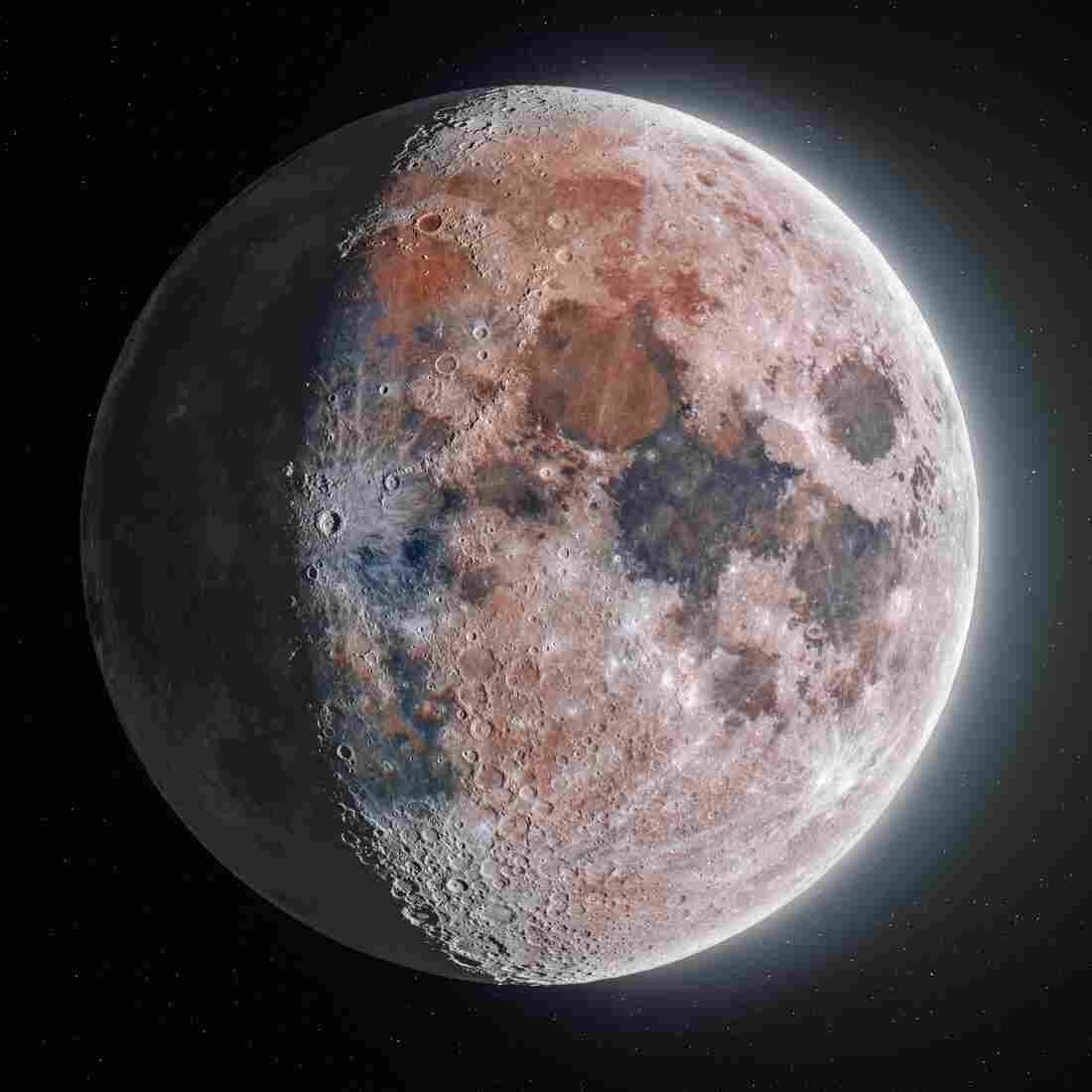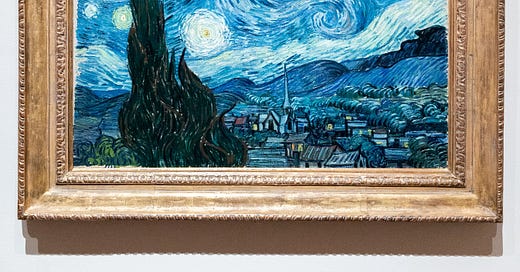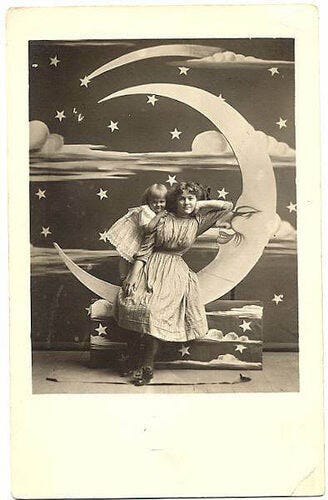The Moon!
My kids were disappointed that the super blue moon a couple days ago wasn't actually blue... hoping this guide will show them it's still super!
“With freedom, flowers, books, and the moon, who could not be perfectly happy?”
—Oscar Wilde, from De Profundis
Throughout history, humans have been awed by the moon. We’ve told stories about it and celebrated it. We dreamed of traveling to the moon, and then we actually did it! I know for myself, anytime I see a big, bright, full moon, I catch my self wide-eyed and excited to share it with someone else. And my girls think it’s just the best thing ever when they spot the moon out during the day, and then we always say, “What are you doing, Moon? It’s the middle of the day! You should be asleep!”
Sharing that delight with my girls - and wanting to share it with you so that you can share it with the children in your life - is the whole reason for these Fort Bramble guides. I hope they spark your wonder.
What you’ll find in The Moon guide:
Moon Books to Read Together
Snack Time: Crackers and Moon Cheese
Invitation to Play: Make Moon Craters
Invitation to Play: Sponge Paint Moon
Guides are available to all subscribers for 1 month after they come out, and then they’ll go into the archive which is available to paid subscribers.
11 moon books to read with your kids.
The Moon Over Star by Dianna Hutts Alston, illustrated by Jerry Pinkney
What the Moon Is Like by Franklyn M. Branley, illustrated by True Kelley
Max and the Tag-Along Moon by Floyd Cooper
The Usborne Book of the Moon by Laura Cowan, illustrated by Diana Toledano
The Children’s Moon by Carmen Agra Deedy, illustrated by Jim LaMarche
Bringing Down the Moon by Jonathan Emmett, illustrated by Vanessa Cabban
The Moon Inside by Sandra V. Feder, illustrated by Aimée Sicuro
Field Trip to the Moon by John Hare
A Big Mooncake for Little Star by Grace Lin
Margaret and the Moon: How Margaret Hamilton Saved the First Lunar Landing by Dean Robbins, illustrated by Lucy Knisley
When Moon Fell Down by Linda Smith, illustrated by Kathryn Brown
I hope you’ll find a new favorite book on this list! I’ve linked to Amazon for the sake of convenience, but Bookshop.org, AbeBooks, ThriftBooks, and eBay are all great places to shop for books. And as always, nothing beats borrowing from your local public library.
Moon videos to watch with your kids.
🌕 Let’s Go Luna: She is the Moon of Moons (PBS Kids, 26 minutes)
🌔 Apollo 13 Views of the Moon (NASA Goddard, 3 minutes)
🌒 Having Fun On the Moon (CNN, 3 minutes)

“Those are the same stars, and that is the same moon, that look down upon your brothers and sisters, and which they see as they look up to them, though they are ever so far away from us, and each other.”
—from The Narrative of Sojourner Truth (1850)
A moon poem.
“Half Moon, Small Cloud”
by John Updike
Caught out in daylight, a rabbit’s
transparent pallor, the moon
is paired with a cloud of equal weight:
the heavenly congruence startles.
For what is the moon, that it haunts us,
this impudent companion immigrated
from the system’s less fortunate margins,
the realm of dust collected in orbs?
We grow up as children with it, a nursemaid
of a bonneted sort, round-faced and kind,
not burning too close like parents, or too far
to spare even a glance, like movie stars.
No star but in the zodiac of stars,
a stranger there, too big, it begs for love
(the man in it) and yet is diaphanous,
its thereness as mysterious as ours.That’s so interesting!
Here are a handful of fascinating links about the moon that I found while putting this guide together. Give your grown-up sense of wonder a little jolt!

➵ Watch: How Far Away is the Moon? (Veritasium) “If the Earth were the size of a basketball and the moon a tennis ball, how far apart would they be? Diagrams that are not to scale make us think that they’re closer than they really are.”
➵ Watch: The Moon Illusion (AsapScienct) Why does your brain think the moon looks enormous sometimes? Because your brain is playing tricks on you!
➵ Read: Designing a Moon-Orbiting Outpost (Fortune) “Designing habitation systems for life on the Moon is about as difficult as it sounds. But beyond the obvious (extreme temperatures, a lack of oxygen, and the deadly vacuum of outer space), setting up shop on the lunar surface presents numerous challenges.”
➵ Watch: Where did the Moon come from? A new theory (TED Salon) “The Earth and Moon are like identical twins, made up of the exact same materials—which is really strange, since no other celestial bodies we know of share this kind of chemical relationship. What's responsible for this special connection?”
➵ Read: Imagining the Moon (New York Times) “The moon in art has changed from symbol to something real, but that hasn’t changed our will to see it.”
“The moon is both magical and familiar. We admire its magnitude; we know we’ll likely never brush our fingers along its craters or walk on its dusty floor. But we go through life seeing it so often, a comforting constant watching over us. Its greatness feels almost—almost—comprehensible. When we gaze up and appreciate the moon, we can feel the kind of fondness one might for a kindred spirit. Sometimes…it can even seem, to us, almost human.”
—Faith Hill for The Atlantic
I hope you loved The Moon guide! For more Discovery & Play Guides, click this green button here for the full archive.
Signing off, luna moth!
Love, Kathryn
🌕 🌖 🌗 🌘 🌑 🌒 🌓 🌔 🌕
Fort Bramble is ad-free and does not use affiliate links. You can support the work that goes into these guides by…
Forwarding this email to a friend.
Sharing this post to Facebook.
Hitting the heart button below.
Becoming a subscriber.
Upgrading your subscription.
Leaving a (kind, curious, or thoughtful) comment.







